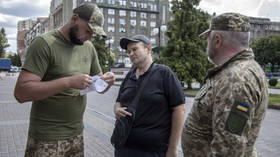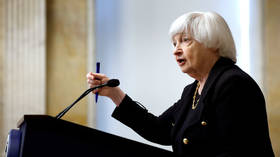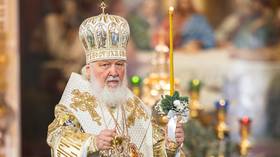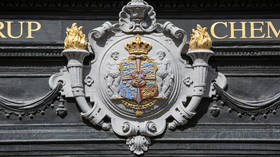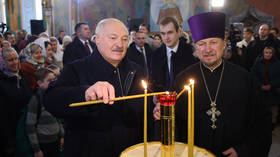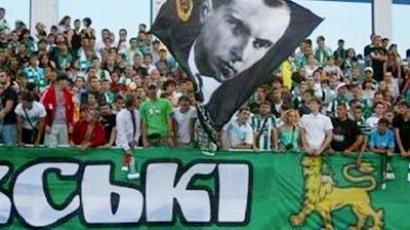Murky depths of Ukrainian nationalism
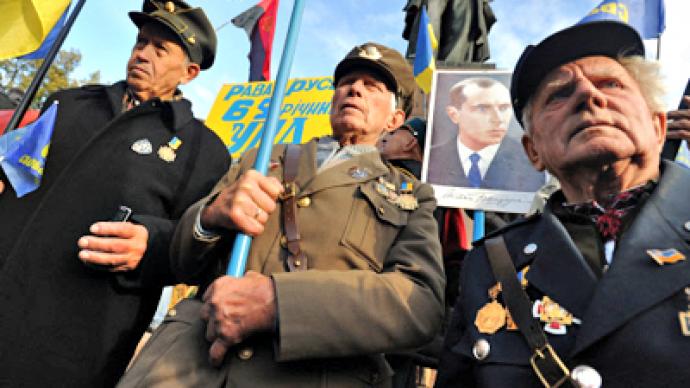
A major nationalist rally in Ukraine’s capital has turned out to be more peaceful and less massive than expected. But with public discontent on the rise, it is hard to predict how things will unfold during next year’s key nationalist anniversary.
“Death to Russia!” “Death to our enemies!” “Glory to Ukraine!” Every year on October 14, these resounding slogans thunder around the central streets of Ukraine’s capital, Kiev. This is the day when Ukrainian nationalists celebrate a landmark anniversary – the birthday of the 1940s insurgent army, commonly referred to as UPA. A several-thousand-strong mob of aggressive youths – mostly football hooligans, hiding their faces behind masks, and aged nationalists, including surviving UPA veterans – flock to central Kiev for a rally. The gathering is traditionally followed by a march through the streets, at times leading to violent clashes with either communist youths or the police. For the past decade, the UPA birthday has been visible proof of an ideological schism in Ukraine. Nationalists see the insurgents as their heroes, demanding Kiev, and the rest of the world, recognize the 1940s movement as heroic. Others – the majority of Ukraine’s population and, in particular, the Communist Party of Ukraine – describe them as Nazi collaborators.
The UPA was formed in 1942 to fight Soviet troops in the west of Ukraine and later joined forces with the Nazi invaders. Later, however, they turned against the German troops – but only after they had been allies of Nazi forces for some time. They conducted ethnic cleansing of western Ukraine, with UPA troops burning entire villages of Russians, Jews and Poles in a gruesome onslaught. Those deeds put them beyond the pale for millions across the Soviet space and beyond.After the USSR collapsed, the tussle over the army’s historic role – namely, the status of its now-dead founders Stepan Bandera and Roman Shukhevich – continued to rock Ukraine’s political elite. Former President Yushchenko made the pair heroes of Ukraine.However, after Yanukovich assumed office, they were stripped of the award. With exquisite timing, Ukraine’s highest administrative court ruled on Friday that the decision to strip Bandera and Shukhevich of the honor cannot be reversed.That only added more fuel to the fire of an already tense situation, spawning fears of further violence at today’s march in a country already going through a period of deep unease.
The 69th anniversary of the insurgent army came just three days after Ukraine was rocked by the seven-year sentence handed down to its former prime minister, Yulia Tymoshenko, for exceeding her powers while she was premier. The three-month trial culminated in the biggest street protests since the 2004 Orange Revolution, as tens of thousands gathered to voice their discontent with the current leadership of President Viktor Yanukovich.That is why many predicted Friday’s UPA march would turn into a massive opposition rally. Analysts suggested it could gather more than 50,000 people. The consequences of such a large-scale protest would have been hard to predict, bearing in mind the violence of the past, provoked by far smaller numbers. The demonstration started in its traditional manner with harsh anti-Russian, anti-Jewish and anti-government statements from the rostrum at the foot of the Taras Shevchenko monument. “We want a free Ukraine, free from the bandits of Donetsk in power,” shouted the Svoboda movement leader, Oleg Tyagnibok, referring to president Viktor Yanukovich, “Free from Moscow’s influence. That’s why we demand the dissolution of parliament and call for early elections.” The applauding crowd cheered his words with loud chants of “Glory to Ukraine!”
After two hours of revolutionary chants, the crowd began their march through Kiev’s streets. From higher vantage points, it seemed the flow of people was endless – it appeared the marching mob consisted of at least 20-30,000 people. However, Ukraine’s interior ministry insists the number of protesters did not reach 10,000. The followers of the UPA were not joined by other opposition movements – only a few flags of Yulia Tymoshenko’s party were seen among the marching crowds. The police presence, on the other hand, was massive – thousands of heavily-armoured officers prevented the marchers from making even the slightest deviation from their set route. So they marched on, shouting abusive chants and singing their army’s songs.The speculation was proved false and this traditionally uneasy day did not end in violence. The crowd reached Mikhailovskaya Square where they stayed for a celebratory concert. In just one hour, their number diminished three-fold. Next year, they will be celebrating the 70th anniversary of the UPA’s foundation. And with the mounting public discontent in Ukraine, God only knows whether October 14 2012 will pass off as peacefully.
Aleksey Yaroshevsky, RT


